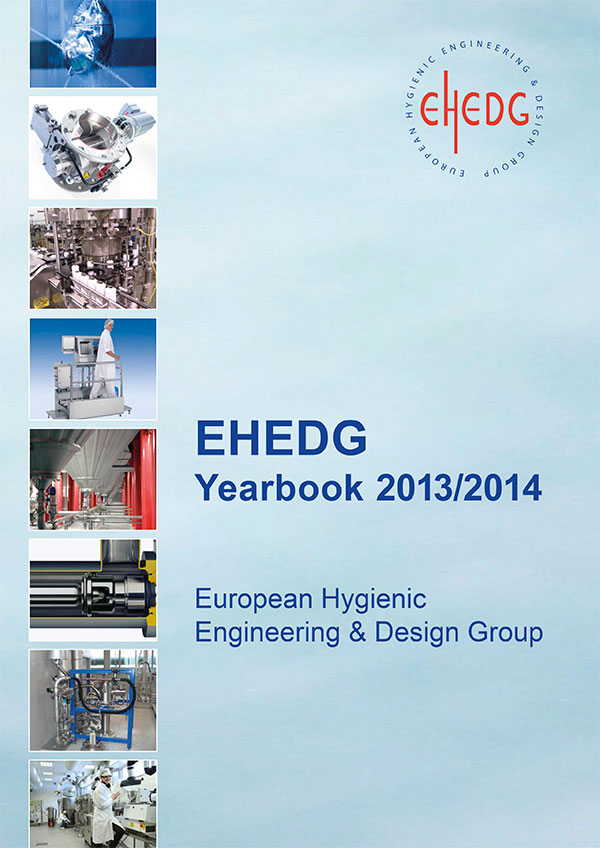EHEDG Document
The European Hygienic Engineering & Design Group (EHEDG) is a consortium of equipment manufacturers, food industries, research institutes as well as public health authorities and was founded in 1989 with the aim to promote hygiene during the processing and packing of food products.
The principal goal of EHEDG is the promotion of safe food by improving hygienic engineering and design in all aspects of food manufacture.
EHEDG actively supports European legislation, which requires that handling, preparation processing and packaging of food is done hygienically using hygienic machinery and in hygienic premises (EC Directive 2006/42/EC for Machinery, EN 1672-2 and EN ISO 14159 Hygiene requirement).
Contents
Articles Page
Greeting from the President, Knuth Lorenzen, EHEDG President 5
News from the Treasurer, Piet Steenaard, EHEDG Treasurer 6
News from the Secretariat, Susanne Flenner, EHEDG Secretariat 7
EHEDG Executive Committee members 8
EHEDG Company and Institute members 10
EHEDG membership 15
Test and Certification Institutes 16
Legal requirements for hygienic design in Europe, by Hans-Werner Bellin, BELLINconsult 17
The importance of hygienic design: A process facility case study and checklist, 20
by Carolina López Arias, Kraft-Foods España (part of Mondelēz International)
Solving concrete kerb challenges to ensure hygiene and food safe wall protection 26
in manufacturing environments, by Nick Van den Bosschelle, PolySto
Hexagonal tile floors: The hygienic foundation of production areas, 28
by Volker Aufderhaar, Argelith Bodenkeramik
Research on hygienic flooring systems: Particle and VOC emissions, 30
chemical and biological resistance, and cleanability,
by Markus Keller and Udo Gommel, Fraunhofer Institute for Manufacturing Engineering
and Automation IPA, Department of Ultraclean Technology and Micromanufacturing
Hygienic design of floor drainage components, by Martin Fairley, ACO Technologies plc 42
Hygienic design of high performance doors for utilisation in the food industry, 47
by Daniel Grüttner-Mierswa, Albany Door Systems GmbH
Performance testing of air filters for hygienic environments: 50
Standards and guidelines in the 21st century,
by Thomas Caesar, Freudenberg Filtration Technologies SE & Co. KG
Spray cleaning systems in food processing machines and the simulation of CIP-coverage tests, 54
by André Boye, Marc Mauermann, Daniel Höhne, Jens-Peter Majschak, Fraunhofer Application Center
for Processing Machinery and Packaging Technology AVV, and Technische Universität Dresden,
Faculty of Computer Science, Institute of Software- and Multimedia-Technology, Dresden, Germany
Environmentally friendly water based surface disinfectants, 60
by Stephan Mätzschke, BIRFOOD GmbH & Co. KG
Flow behaviour of liquid jets impinging on vertical walls, 66
by Ian Wilson, Tao Wang and John F. Davidson, Department of
Chemical Engineering and Biotechnology, University of Cambridge
Optimisation of tank cleaning, by René Elgaard, Alfa Laval Tank Equipment A/S 70
Effective tank and vessel cleaning: How different systems can help meet today’s demands, 76
by Falko Fliessbach, GEA Breconcherry
Practical considerations for cleaning validation, by Hein Timmerman, Diversey 83
Integrated hygienic tamper-free production, by Stefan Åkesson, Tetra Pak 85
Damage scenarios for valves: Identifying the potential for optimisation, 87
by Willi Wiedenmann, Krones AG
Infection-free preparation of bacterial cultures, by Ludger Hilleke, amixon GmbH 92
Modern level detection and measurement technologies, by Daniel Walldorf, Baumer GmbH 94Contents 3
An example of the development process of hygienic process sensors: A hygienic level switch, 96
by Holger Schmidt, Endress+Hauser
Storage in silos and pneumatic conveying of milk powder with up to 60% fat content, 99
by Hermann Josef Linder, Solids Solutions Group, S.S.T.-Schüttguttechnik Maschinenbau GmbH
Material and design optimisation calculated by EHEDG: Tubing systems, 103
by Torsten Köcher, Dockweiler AG
Improved hygienic design and performance of food conveyor belts, by Olaf Heide, Habasit AG 106
Smart hygienic solutions for the food industry, 108
by Peter Uttrup, Interroll España S.A and Lorenz G. Koehler, Interroll (Schweiz) AG
Examination of food allergen removal from two flat conveyor belts, 110
by Zhinong Yan, Gary Larsen, Roger Scheffler, and Karin Blacow. Intralox, L.L.C.
The future of food-grade lubrication, by Taco Mets, Van Meeuwen Groep B.V. 115
Hygienic automation technology in food production, by Alexander Wagner, Fest


















